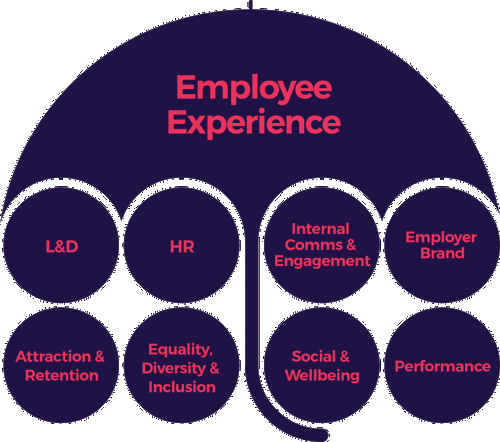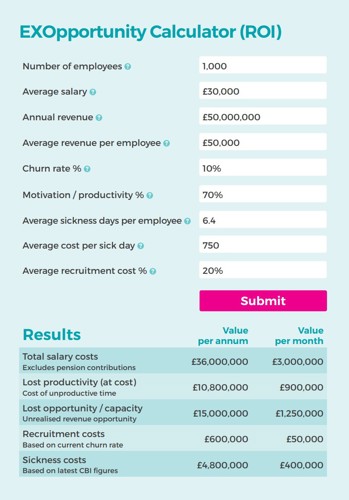Employee Experience Explained
In this summary article on Employee Experience, we outline:
- What Employee Experience is
- Where Employee Experience sits within an organisation
- Why you should invest in it
- Where to start with your Employee Experience efforts
- A framework for improvements
- How Employee Experience impacts upon other business areas
- Important definitions and comparisons
What is Employee Experience?
At Brand Experiences we define the Employee Experience (EX) as:
“The entire relationship between employee and employer. It encompasses every interaction and touchpoint at every stage of the Employee Lifecycle.”
In short, it’s how you treat your employees. So, it’s the relationships and how these are handled; the work environment and if this is conducive to productive work; the culture; and the technology and tools to enable people to do their job well. Employee Engagement, morale, and productivity are all outcomes of a good EX.
Where does Employee Experience sit within an organisation?
We see EX as the umbrella term for all people-related activity within an organisation.

As EX is about putting people at the heart of an organisation, only ‘people-people’ should be given responsibility for it. These people could come from HR, Internal Communications, L&D or even Customer Service (CX) (especially as many of the EX principles come from CX).
In most organisations, HR currently sits at the top of the people tree and so is usually responsible for EX. We predict that, over time, the hierarchy of people functions will change, with EX as the umbrella and HR sitting alongside the likes of L&D and Internal Communications. The person with the seat at the top table will be an EX professional with a background in improving people productivity. After all, as we always say: it’s about the people, stupid!
Why you should invest in the Employee Experience
According to Perkbox research, an excellent EX leads to:
- 2.3x greater revenue growth
- 5x better shareholder return
- 21% higher profitability
- 17% higher productivity
- 10% increase in customer ratings
With stats like these, it’s a wonder why EX isn’t a top three priority for every CEO. But it clearly isn’t as worldwide productivity and engagement levels are so low. This is despite this statement coming from the mouths of almost every CEO:
“Our employees are our best asset”
The evidence points to there clearly being a say-do gap. Your EX shouldn’t be ignored as it can offer a compelling ROI, which benefits everyone: customers, employees and stakeholders. Ask yourself:
- How much does your organisation spend on attracting new customers and attempting to keep current ones happy versus attracting new talent and keeping employees happy?
- How much does your organisation spend on tech and tools to support an effective CX versus how much is spent on an effective EX?
- How many employees do you have designing and improving touchpoints on the customer journey versus how many employees do you have designing and improving touchpoints on the employee journey?
Employee Experience is undervalued and underfunded
Only those who aren’t on LinkedIn will have missed Richard Branson’s quote: “Clients do not come first. Employees come first. If you take care of your employees, they will take care of your clients.” The customer may well be king, but the king will soon look for different subjects if served with indifference. It’s baffling that many senior leaders seem to expect their employees to offer an exceptional customer service, while offering them an exceptionally poor one.
Employee Experience has a more compelling ROI than CX
Yes, you read that right. It’s easier to obtain, quicker to realise, and potentially more valuable. If an organisation of 1,000 employees has an annual revenue of £220M, and a sales campaign yielded £1M, then this would be widely celebrated. If the same organisation improved the motivation of its employees by just 5%, they can improve lost productivity by £1.6M—and that’s every year on an ongoing basis. EX is a gift that keeps on giving, unlike gambling on sales campaigns. And retained, motivated employees are likely to contribute to sales. So why don’t all senior leaders recognise this?
Remarkably, given its broad reach, EX is not just often considered a poor relation to CX, but also to some internal functions. For example, IT has made the case for investing in tech and therefore money is readily dished out for new tools and pieces of equipment. Governance has made the case for investing in fail safe data processes and receives good levels of funding towards this end. Have you ever heard of someone ‘doing Governance’ as an add-on? No, so why are many EX activities performed by HR employees as an add-on to their duties?
From our experience, in most organisations, EX just happens. It’s a collection of siloed touchpoints owned by different people, each reflecting the personality of that person. It’s rare that we find an organisation that has an EX strategy, let alone defined Employee Journey Maps, Empathy Maps and Employee Lifecycles. To fully drive this point home, imagine if you let your CX just ‘happen’? The outcome would be disastrous—the same goes for EX.
Proving the ROI of Employee Experience
Organisations are simply more used to investing in CX than EX and will naturally assume that there’s a stronger ROI for CX. Clearly demonstrating the ROI for EX is the only way to bust this myth and create a compelling case for EX to have parity with CX, at the very least.
Departments, of course, compete for budget and CFOs will allocate funds either simply where they’ve been allocated before or where there is evidence of a strong ROI. We clearly see the value of investing in CX, but there’s a wealth of uncertainty about the ROI and it’s simply quicker and easier to shift the needle on the ROI for EX than CX.
Part of the problem in obtaining budget for EX has been a woeful lack of business awareness from so-called (or self-declared) thought leaders in the Internal Communications/Employee Engagement/Employee Experience space. Courses on ‘what to measure’ focus on aspects such as views, clicks, and engagement rates. With this in mind, it’s no wonder that other popular courses in these industries are around achieving a seat at the top table (which they don’t seem to be achieving). Views, clicks, and engagement rates are of interest to comms people and can be used to assess the success of a piece of content. But they’re meaningless measures to senior leaders unless the desired outcome from the communication occurs.
To give an example—if an organisation were to launch a medical cashback scheme, where employees could claim back for dentistry, new glasses, massages etc., then it would be of interest to the comms team to see how many employees read the launch story. But to no one else. This, if you like, is level one metrics. The next level up would be to see how many people had signed up to the scheme. Finally, the organisation would have financed this scheme and would hope that more money would be claimed back from it than spent on it. It’s this figure that the CFO would be most interested in. This ROI would be level three.
Ultimately, businesses are mostly focused on competitive advantage, growth, and profitability—but these can’t be measured via the fluffy stuff, such as clicks, views, and engagement rates. The golden goose is to correlate EX activities to the bottom line. So, measuring ROI = great; measuring behaviour change = very good; measuring views and clicks = is that the best you’ve got?
The bigger the better - where numbers are concerned
Individual campaign ROI success rates are one thing but to catch the eye of senior leaders in order to kick-start real investment in EX you’ll need to do better than that. Using evidence from internal or industry surveys and data from other organisations can feel rather abstract to decision makers and so we’ve devised the EXOpportunity Calculator™ so that you can share with your own senior leaders the impact of a motivated, productive workforce.
The EXO Opportunity Calculator
The beauty of this is that it is not generic; you can use data about your own organisation.
To get the most accurate result, you will need to have undertaken a mojo motivation mapping exercise at your organisation. However, in lieu of having these figures, you could do an indicative calculation using the average motivation percentage of 65% or even substituting the motivation % figure with satisfaction % levels. As there’s no proven correlation between satisfaction and motivation, you couldn’t use this as a ‘real’ figure.
However, a substitute figure can help you to see immediately how the calculator works and the potential opportunity that comes from investing in your employees’ motivation and experience. As we keep saying, motivation is integral to productivity, which is why it forms a part of this calculator.
Here is a breakdown of the different metrics the calculator considers:
- Number of employees: Add the number for your organisation based on total headcount
- Average Salary: Add the average number for your organisation
- Annual Revenue: Add the actual number for your organisation
- Average Revenue per employee: Annual Revenue/No of employees
- Churn Rate %: Add the exact number for your organisation
- Motivation %: The organisation-wide score from mojo maps
- Total Salary Costs: No of employees X Average Salary X 1.2 (to allow for employer NI)
- Lost Productivity at Cost: Total Salary Costs X (100%—Motivation %) = Cost of Unproductive Time
- Lost Opportunity / Capacity: Annual Revenue X (100%—Motivation %) = Unrealised Revenue
- Recruitment Costs: (Churn % X No of Employees) X Average Salary X Average Recruitment Cost
- Sickness & Absence Costs: Taken from the CBI calculations

As you can see, the EXOpportunity is substantial and taking advantage of it has never been more important or achievable. It is interesting to note that a seemingly small percentage shift in motivation and productivity can have rather large financial implications for businesses of all sizes. Armed with a compelling ROI calculation for their organisation, EX teams can have powerful conversations with senior leaders to secure support and budget for EX improvements.
Where to start with your Employee Experience efforts
An Employee Experience Audit: If you don’t know your past then you don’t know your future – so, this is the place to start. These are a deep exploration of what your people are thinking, feeling and doing; aimed at improving the working lives and performance of your employees. You can read more about this here.
Write the Employee Experience strategy: To give you a clear definition of what you are trying to achieve, you need to define the EX strategy. Your published EX strategy should include a high-level roadmap showing key objectives, milestones, and deliverables. You can read more about this here.
Improve the Employee Experience: The more friction-free the experiences, the better. And as the people who actually do the work know and understand it the best, these are the people who should be involved in the creation of the experiences to understand how friction can be reduced and quality improved. You can read more about this here.
A framework for Employee Experience improvements
Once you’ve undertaken your Employee Experience (EX) research via an EX Audit and then created your strategy, then it’s time to get going with your EX efforts. For this you need an EX framework.
Our suggested framework is as follows.
The Employee Lifecycle: Defining this will help to shape the potential scope of your EX activities over the long term. The Employee Lifecycle encompasses every interaction between an employee and an organisation, which covers a huge number of processes, journeys and experiences. You can read more about this here.
The Moments that Matter: These are opportunities to surprise and delight an employee and make them feel positive towards their employer. These should be peppered throughout the Employee Lifecycle. You can read more about this here.
Employee Journey Mapping: Before we can truly understand how to improve an Employee Journey, we need to understand the current situation, so it is important to map the current Employee Journey in detail first. It’s then about breaking activities down into manageable chunks and interrogating each Moment that Matters to make it the best it can possibly be. You can read more about this here.
Employee Archetypes: Where you have different types of employees that are likely to have a different experience, then it is important to understand their different needs, wants and pains. To support this understanding, we recommend creating Employee Archetypes and map the journey for each Archetype separately. You can read more about this here.
Empathy Maps: These force us to put ourselves in the shoes of employees to consider their emotional or physical responses during specific experiences. Empathy Maps are about getting inside the head of your employees to understand what they might be saying, thinking, doing or feeling during an experience. You can read more about this here.
Change Canvas: To test and review new or existing employee journeys and experiences, it is useful to have a structured retrospective approach to obtaining feedback. In short, you will obtain feedback on what’s going right, what’s going wrong and where the challenges and opportunities are. You can read more about this here.
Employee motivation: If you desire a strong ROI from your people, then increasing motivation is key. Our motivation platform mojo will support with achieving this. If you work backwards, profit is impacted by performance, which is impacted by productivity, which is impacted by the often-overlooked motivation. You can read more about this here.
Employee Experience measurement: As well as continuing with current metrics such as survey scores, absence rates, turnover rates, external benchmarking sites etc.; we recommend measuring improvements in motivation levels and satisfaction of the Moments that Matter. You can read more about this here.
How Employee Experience impacts other business areas
EX has all kinds of links, correlations and impacts. Some of which are:
How Employee Experience impacts upon the Customer Experience: EX and CX should be considered as two equal sides of the same coin. Which is why, back in 2019, we created the Employee Experience Opportunity (EXO), to encourage parity between them.
The difference between Employee Experience and Employee Engagement: EX is the sum of all interactions an employee has with their employer and the workplace environment. Employee Engagement refers to the level of commitment and involvement that an employee has towards their job and the organisation. You can read more about this here.
Employee Experience surveys: These will aid you in understanding how your employees are feeling about working life at your organisation. If done effectively, it can help to prioritise the important issues. There are three main types of EX surveys: eNPS, Pulse and Full/Annual. You can read more about this here.
‘Loud Quitting’ and ‘Quiet Quitting’: Loud Quitting is where employees openly and publicly express their dissatisfaction with their jobs and their intentions to leave the company. Quiet Quitting is where employees exhale only the bare essentials during working hours and leave their jobs without directly expressing their frustrations. You can read more about this here.
Why Employee Experience initiatives fall short: Whereas employees think EX is vital to organisational success, senior leaders are not investing time, resources and budgets to create better experiences. Why? As with everything, there's seldom one single reason and you can read more about these here.
What Employee Experience jobs are available: EX professionals focus upon improving the culture and driving productivity. Roles range from Employee Experience Assistant to Employee Experience Manager to Chief People Officer. You can read more about this here.
Employee Experience courses
If you’re unsure what EX entails, how to build the business case for it, how to get started with your EX efforts, or what tools are on offer to create good-to-great experiences, then we currently offer three courses to support you:
- Introduction to Employee Experience Masterclass
- The EX Toolkit: Your go-to place to create great Employee Experiences
- The Employee Lifecycle: Creating Moments That Matter
You can read more about these courses here.
In summary
EX is about putting people at the heart of every organisation, because everyone matters at work. Effective EX leads to a more motivated, engaged and productive workforce - which will, ultimately, lead to a positive impact upon the bottom line.


